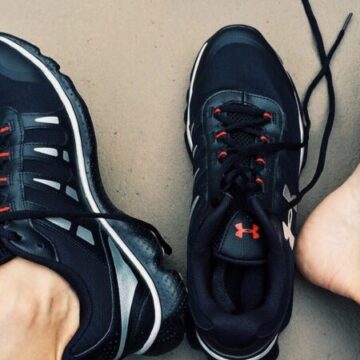
-
- Cushioned shoes may weaken the signal between the feet and the brain.
- Exercising barefoot is possible, but not without risks.
- When deciding to exercise barefoot, make sure to allow your feet to adapt first.
Your shoes may be doing your feet more harm than good, including those comfy sneaks you wear when running errands or doing physical activities.
According to experts, wearing cushioned shoes may be dulling the communication between your feet and brain, negatively affecting your balance, stability, and foot strength. It may also make your feet extra sensitive and cause your ankles to weaken over time.
But before you go shoes-free, know that such a lifestyle also comes with risks.
Before kicking your shoes off, know the pros and cons of going barefoot.
Why you should spend more time barefoot

Dr. Paul Langer, a podiatrist from Twin Cities Orthopedics, says going barefoot doesn’t constrict the feet’s natural shape, allowing your muscles and joints to work more, making your feet strong, your toes aligned, and your joints mobile.
Langer says that when barefoot or wearing shoes with minimal cushioning, we tend to take longer strides, which supports the limbs’ absorption of impact in the feet, ankles, knees, and hips.
According to some studies, cultures that go barefoot have different foot morphology compared to those that wear shoes. Langer cites Swiss pioneer of podiatry Benno Nigg, who said that shoes filter the sensory signals between the feet and the brain.
Langer says while there haven’t been any studies that show long-term effects of footwear in proprioception, he says that lesser sensory input between the feet and the brain alters proprioception.
That means that going barefoot allows our feet to send a stronger signal to our brain, improving balance and agility over time.
Going barefoot long enough also leads to callus build-up that offers natural protection.
Is it safe to exercise barefoot?

Dr. Langer says that while you can exercise barefoot, it comes with the following risks:
- Scraping or cutting your feet
- Stubbing your toes
- Stepping in something gross that may cause a bacterial or fungal infection
- Dropping equipment on your toes
If you’re just starting, you may also be unstable and off-balance since your feet are used to the support and stability from cushioned shoes.
The kind of exercise you do and where you do it also determines whether it’s safe to exercise barefoot. It may be unsafe to walk or run barefoot in filthy neighborhood streets, but it might not be the case when you’re running on a sandy beach.
If you want to try working out barefoot but are hesitant, you could start with minimal shoes.
How to start exercising barefoot

Dr. Langer warns against exercising barefoot right away. Start by walking around your house and your yard barefoot to reintroduce the sensations of walking on different surfaces to your feet.
You can then try yoga and bodyweight strength training. These exercises don’t have the risk of dropping objects on your toes and help you “get to know” your feet and how they support you, says Dr. Langer.
You may eventually work yourself up to go on longer walks outdoors or lift weights barefoot, provided you keep your feet out of the way of weights. Ballistic workouts come with greater risk.
Potential risks of the barefoot lifestyle

Dr. Langer says the biggest risks of going barefoot are making the transition too quickly and not allowing for adaptation.
Not allowing your feet to adapt first can cause severe soreness in your heels, arches, ankles, calves, knees, and hips.
Benefits of cushioned shoes

For people who have foot injuries or pain, proper cushioning is essential. If barefoot or minimalist shoes cause pain, Dr. Langer says to limit how much you should wear them or whether you should try them at all.
Cushioning provides comfort and slows down the onset of muscle fatigue, says Dr. Langer.
He cites Benno Nigg, “There is likely an ideal amount of cushioning for each of us. We just don’t have a way to measure what it might be.”
Via CNet
